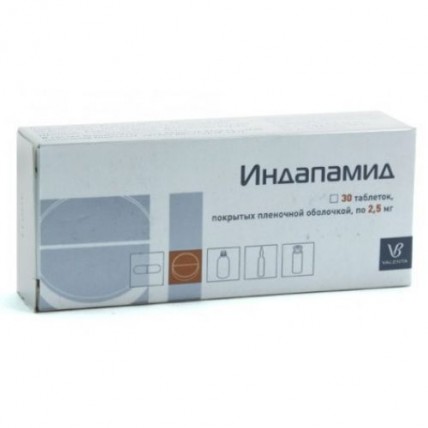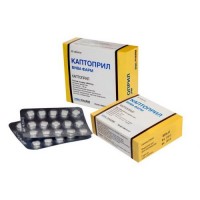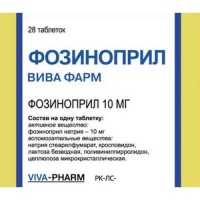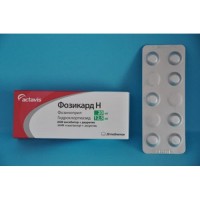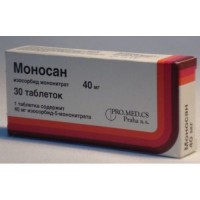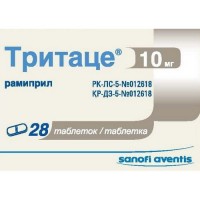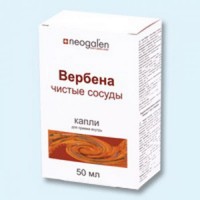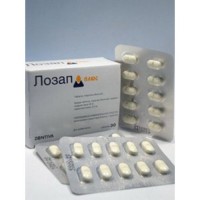Indapamide 30s 2.5 mg coated tablets
- $6.00
The instruction
for medical use
of Indapamid Torgovoye medicine a name
Indapamid
Mezhdunarodnoye the unlicensed
name Indapamid Lekarstvennaya
the Tablet form, film coated, 2.5 mg
Structure
One tablet contains
active agent: indapamid – 2.5 mg,
excipients: lactoses monohydrate, cellulose microcrystalline, starch prezhelatinizirovanny, silicon dioxide colloidal, magnesium stearate,
structure of a cover: Opadray II 85F18422
(the polyvinyl alcohol which is partially hydrolyzed, a macrogoal-3350, talc, the titan E 171 dioxide)
the Description
Round biconvex tablets, film coated white or almost white color
Pharmacotherapeutic group
Diuretics. Not thiazide diuretics operating on a cortical segment of a Henle's loop. Sulfonamides. Indapamid.
The ATX C03BA11 code
the Pharmacological
Pharmacokinetics Later properties of intake is quickly and completely soaked up from digestive tract, bioavailability – high (93%). Meal slows down absorption speed a little, but does not affect amount of the soaked-up substance. The maximum concentration in blood plasma is reached in 1-2 hours after intake. At repeated methods of fluctuation of concentration of drug in blood plasma in an interval between receptions of two doses decrease. Equilibrium concentration is established in 7 days of regular reception. Elimination half-life of drug makes 14-24 hours (on average 18 hours), communication with proteins of blood plasma - 79%. Contacts also elastin of unstriated muscles of a vascular wall. Has the high volume of distribution, passes through gistogematichesky barriers (including placentary), gets into breast milk. It is metabolized in a liver. Kidneys remove 60 - 80% in the form of metabolites (in not changed look about 5% are removed), through intestines – 20%. At patients with a renal failure the pharmacokinetics does not change. Does not kumulirut.
Pharmacodynamics
Antihypertensive (diuretic, vazodilatator). On pharmacological properties it is close to thiazide diuretics (disturbance of a reabsorption of ions of sodium in a cortical segment of a Henle's loop). Increases discharge kidneys of ions of sodium, chlorine to a lesser extent of potassium ions and magnesium. Having ability to selectively block slow calcium channels, increases elasticity of walls of arteries and reduces obshcheeperiferichesky vascular resistance. Promotes reduction of a hypertrophy of a left ventricle of heart. Does not influence the maintenance of lipids in blood plasma (triglycerides, lipoproteins of low density, lipoproteins of high density), does not influence carbohydrate metabolism (including at patients with the accompanying diabetes). Reduces sensitivity of a vascular wall to noradrenaline and angiotensin II, E2 prostaglandin stimulates synthesis, reduces products of free and stable oxygen radicals.
The hypotensive effect develops by the end of the first week, remains within 24 hours against the background of single dose.
Indications
- arterial hypertension
Inside, irrespective of meal time, washing down the Route of administration and doses with enough liquid. It is preferable to take the drug in the morning. The dose makes 2.5 mg (1 tablet) a day. If in 4-8 weeks of treatment the desirable therapeutic effect is not reached, the dose of drug is not recommended to be raised (the risk of emergence of side effects without strengthening of antihypertensive effect increases). Instead it is recommended to include other antihypertensive drug which is not diuretic in the scheme of drug treatment.
In case treatment needs to be begun with intake of two drugs, Indapamid's dose remains equal 2.5 mg in the morning once in day.
Side effects
from digestive system: nausea, anorexia, dryness in a mouth, a gastralgia, vomiting, diarrhea, a constipation, an abdominal pain, development of hepatic encephalopathy is possible, it is rare – pancreatitis.
From sense bodys: conjunctivitis, disorder of vision.
From the central nervous system: an asthenia, nervousness, a headache, dizziness, drowsiness, vertigo, insomnia, a depression, it is rare – increased fatigue, the general weakness, an indisposition, a spasm of muscles, tension, irritability, feeling of alarm.
From a respiratory system: cough, pharyngitis, sinusitis, it is rare – rhinitis.
From a cardiovascular system: orthostatic hypotension, changes on the ECG (lengthening of an interval of an interval of Q-T), arrhythmia, heartbeat.
From an urinary system: frequent infections, nocturia, polyuria.
Allergic reactions: skin rash, itching, small tortoiseshell, hemorrhagic vasculitis, Quincke's disease, toxic epidermal necrolysis, Stephens-Johnson's syndrome.
Laboratory indicators: a hyperuricemia, a hyperglycemia, a hypopotassemia, a hypochloraemia, a hyponatremia, a hypercalcemia, increase in urea nitrogen blood plasma, a giperkreatininemiya, a glucosuria.
From bodies of a hemopoiesis: thrombocytopenia, leukopenia, agranulocytosis, aplasia of marrow and hemolytic anemia
Other: aggravation of a system lupus erythematosus, a grippopodobny syndrome, thorax pain, a dorsodynia, an indisposition, decrease in a libido, a rhinorrhea, the increased sweating, decrease in body weight, pricking in extremities, is possible developing of a liver failure, simultaneous loss of ions of chlorine can lead to a secondary compensatory metabolic alkalosis (frequency and degree of this effect – weak).
Contraindications
- hypersensitivity to drug, other derivatives of sulfonamide
- a lactose intolerance, a galactosemia, a syndrome of disturbance of absorption of a glucose/galactose
- the profound renal failure (anury stage)
- a hypopotassemia
- expressed hepatic (including with encephalopathy) insufficiency
- pregnancy and the period of a lactation
- children's and teenage age up to 18 years (the efficiency and safety are not established).
With care appoint in abnormal liver functions and/or kidneys, disturbance of water and electrolytic balance, a hyperparathyreosis, the patient with the increased Q-T interval on the ECG or a concomitant use of the medicines extending an interval Q-T, diabetes in a decompensation stage, a hyperuricemia (especially, the followed gout and an uratny nephrolithiasis).
Medicinal interactions
Saluretics, cardiac glycosides, glyuko- and mineralokortikosteroida, tetrakozaktid, Amphotericinum B (at in in introduction), depletive increase risk of development of a hypopotassemia.
At simultaneous use with cardiac glycosides the likelihood of developing digitalis intoxication, with calcium drugs – hypercalcemias, with metformin – possibly aggravation of lactic acidosis raises.
Increases concentration of ions of lithium in blood plasma (decrease in removal by kidneys), lithium has nephrotoxic effect.
Astemizol, erythromycin (at in in introduction), pentamidine, sultoprid, terfenadin, Vincaminum, antiarrhytmic means of IA of a class (quinidine, Disopyramidum) and the III class (Amiodaronum, a bretylium tosylate, sotalol) can lead ment of arrhythmia in the pirouette type (torsades de pointes).
Non-steroidal anti-inflammatory drugs, glucocorticosteroid means, tetrakozaktid, sympathomimetics reduce hypotensive effect, Baclofenum – strengthens.
The combination with kaliysberigayushchy diuretics can be effective at some category of patients, however, at the same time the possibility of development hypo - or hyperpotassemias, especially at patients with diabetes and renal failure completely is not excluded.
Inhibitors of the angiotensin-converting enzyme (ACE) increase risk of developing arterial hypotension and/or acute renal failure (especially at the available renal artery stenosis).
Increases risk of developing renal failures when using iodinated contrast means in high doses (organism dehydration). Before use of iodinated contrast agents by the patient it is necessary to restore liquid loss.
Imipraminovy (tricyclic) antidepressants and antipsychotic means (neuroleptics) strengthen hypotensive action and increase risk of developing orthostatic hypotension.
Cyclosporine increases risk of development of a giperkreatininemiya.
Reduces effect of indirect anticoagulants (derivative coumarin or an indandion) owing to increase in concentration of factors of coagulation as a result of reduction of volume of the circulating blood and increase in their products a liver (dose adjustment can be required).
Strengthens the neuromuscular transmission blockade developing under the influence of not depolarizing muscle relaxants.
Special instructions
At the patients taking cardiac glycosides, the laxative drugs against the background of a hyper aldosteronism and also at patients of advanced age the control of maintenance of potassium ions and creatinine is shown.
Against the background of Indapamid's reception should control systematically concentration of potassium ions, sodium, magnesium blood plasma (electrolytic disturbances can develop), rn, concentration of glucose, uric acid and residual nitrogen.
The most careful control is shown at patients with cirrhosis (especially with the developed hypostases or ascites – risk of developing the metabolic alkalosis strengthening manifestations of hepatic encephalopathy), coronary heart disease, chronic heart failure and also at patients of advanced age.
Patients with the increased QT interval on the ECG also treat group of the increased risk (inborn or developed against the background of any pathological process).
The first measurement of concentration of potassium ions in blood should be taken within the first week of treatment.
The hypercalcemia against the background of Indapamid's reception can be a consequence of earlier not diagnosed hyperparathyreosis.
At patients with diabetes it is extremely important to control glucose level in blood, especially in the presence of a hypopotassemia.
Considerable dehydration can lead ment of an acute renal failure (decrease in glomerular filtration).
Patients need to offset loss of liquid and in an initiation of treatment carefully to control function of kidneys.
Indapamid can yield positive take when conducting doping control.
It is necessary for patients with arterial hypertension and a hyponatremia (owing to intake of diuretics) in 3 days prior to intake of APF inhibitors to stop intake of diuretics (if necessary intake of diuretics can be resumed a bit later), or by it appoint initial low doses of APF inhibitors.
Derivatives of sulfonamide can aggravate a course of a system lupus erythematosus (it must be kept in mind at Indapamid's appointment).
Features of influence of medicine on ability to run the vehicle or potentially dangerous mechanisms
are In certain cases possible the individual reactions connected with change of arterial blood pressure, especially in the beginning treatments and at addition of other antihypertensive drug. Therefore the ability to driving and work with the mechanisms requiring special attention can decrease.
Overdose
Symptoms: nausea, vomiting, weakness, dysfunction of digestive tract, water and electrolytic disturbances, in certain cases – an excessive lowering of arterial pressure, respiratory depression. At patients with cirrhosis the development of a hepatic coma is possible.
Treatment: gastric lavage, correction of water and electrolytic balance, symptomatic therapy. There is no specific antidote.
Form of release and packing
of the Tablet, film coated, 2.5 mg.
On 10 tablets in blister strip packaging from a film of the polyvinylchloride and printing aluminum foil varnished.
On 3 planimetric packs together with the instruction for use in the state and Russian languages place in a pack from cardboard.
To Store storage conditions in the place protected from light at a temperature not over 25 of 0C.
To store out of children's reach!
A period of storage
2 years
not to apply after an expiration date
Prescription status
According to the prescription
the Valenta Pharmatsevtika Open joint stock company Producer,
Russia 141101, Shchyolkovo, Moscow Region, Fabrichnaya St., 2
the Owner of the registration certificate
Valenta Pharmatsevtika Open joint stock company,
Russia 141101, Shchyolkovo, Moscow Region, Fabrichnaya St., 2
the Address of the organization accepting in the territory of the Republic of Kazakhstan claims from consumers on quality of products (goods)
Representative office of JSC Valenta Pharmatsevtika in
RK Republic of Kazakhstan, 050009, Almaty, the ave. of Abay, ug. Radostovts St., 151/115, business center Ala Tau, office No. 1102
Phone number / fax 8 (727) 334-15-52
E-mail address:
asia@valentapharm.com
for medical use
of Indapamid Torgovoye medicine a name
Indapamid
Mezhdunarodnoye the unlicensed
name Indapamid Lekarstvennaya
the Tablet form, film coated, 2.5 mg
Structure
One tablet contains
active agent: indapamid – 2.5 mg,
excipients: lactoses monohydrate, cellulose microcrystalline, starch prezhelatinizirovanny, silicon dioxide colloidal, magnesium stearate,
structure of a cover: Opadray II 85F18422
(the polyvinyl alcohol which is partially hydrolyzed, a macrogoal-3350, talc, the titan E 171 dioxide)
the Description
Round biconvex tablets, film coated white or almost white color
Pharmacotherapeutic group
Diuretics. Not thiazide diuretics operating on a cortical segment of a Henle's loop. Sulfonamides. Indapamid.
The ATX C03BA11 code
the Pharmacological
Pharmacokinetics Later properties of intake is quickly and completely soaked up from digestive tract, bioavailability – high (93%). Meal slows down absorption speed a little, but does not affect amount of the soaked-up substance. The maximum concentration in blood plasma is reached in 1-2 hours after intake. At repeated methods of fluctuation of concentration of drug in blood plasma in an interval between receptions of two doses decrease. Equilibrium concentration is established in 7 days of regular reception. Elimination half-life of drug makes 14-24 hours (on average 18 hours), communication with proteins of blood plasma - 79%. Contacts also elastin of unstriated muscles of a vascular wall. Has the high volume of distribution, passes through gistogematichesky barriers (including placentary), gets into breast milk. It is metabolized in a liver. Kidneys remove 60 - 80% in the form of metabolites (in not changed look about 5% are removed), through intestines – 20%. At patients with a renal failure the pharmacokinetics does not change. Does not kumulirut.
Pharmacodynamics
Antihypertensive (diuretic, vazodilatator). On pharmacological properties it is close to thiazide diuretics (disturbance of a reabsorption of ions of sodium in a cortical segment of a Henle's loop). Increases discharge kidneys of ions of sodium, chlorine to a lesser extent of potassium ions and magnesium. Having ability to selectively block slow calcium channels, increases elasticity of walls of arteries and reduces obshcheeperiferichesky vascular resistance. Promotes reduction of a hypertrophy of a left ventricle of heart. Does not influence the maintenance of lipids in blood plasma (triglycerides, lipoproteins of low density, lipoproteins of high density), does not influence carbohydrate metabolism (including at patients with the accompanying diabetes). Reduces sensitivity of a vascular wall to noradrenaline and angiotensin II, E2 prostaglandin stimulates synthesis, reduces products of free and stable oxygen radicals.
The hypotensive effect develops by the end of the first week, remains within 24 hours against the background of single dose.
Indications
- arterial hypertension
Inside, irrespective of meal time, washing down the Route of administration and doses with enough liquid. It is preferable to take the drug in the morning. The dose makes 2.5 mg (1 tablet) a day. If in 4-8 weeks of treatment the desirable therapeutic effect is not reached, the dose of drug is not recommended to be raised (the risk of emergence of side effects without strengthening of antihypertensive effect increases). Instead it is recommended to include other antihypertensive drug which is not diuretic in the scheme of drug treatment.
In case treatment needs to be begun with intake of two drugs, Indapamid's dose remains equal 2.5 mg in the morning once in day.
Side effects
from digestive system: nausea, anorexia, dryness in a mouth, a gastralgia, vomiting, diarrhea, a constipation, an abdominal pain, development of hepatic encephalopathy is possible, it is rare – pancreatitis.
From sense bodys: conjunctivitis, disorder of vision.
From the central nervous system: an asthenia, nervousness, a headache, dizziness, drowsiness, vertigo, insomnia, a depression, it is rare – increased fatigue, the general weakness, an indisposition, a spasm of muscles, tension, irritability, feeling of alarm.
From a respiratory system: cough, pharyngitis, sinusitis, it is rare – rhinitis.
From a cardiovascular system: orthostatic hypotension, changes on the ECG (lengthening of an interval of an interval of Q-T), arrhythmia, heartbeat.
From an urinary system: frequent infections, nocturia, polyuria.
Allergic reactions: skin rash, itching, small tortoiseshell, hemorrhagic vasculitis, Quincke's disease, toxic epidermal necrolysis, Stephens-Johnson's syndrome.
Laboratory indicators: a hyperuricemia, a hyperglycemia, a hypopotassemia, a hypochloraemia, a hyponatremia, a hypercalcemia, increase in urea nitrogen blood plasma, a giperkreatininemiya, a glucosuria.
From bodies of a hemopoiesis: thrombocytopenia, leukopenia, agranulocytosis, aplasia of marrow and hemolytic anemia
Other: aggravation of a system lupus erythematosus, a grippopodobny syndrome, thorax pain, a dorsodynia, an indisposition, decrease in a libido, a rhinorrhea, the increased sweating, decrease in body weight, pricking in extremities, is possible developing of a liver failure, simultaneous loss of ions of chlorine can lead to a secondary compensatory metabolic alkalosis (frequency and degree of this effect – weak).
Contraindications
- hypersensitivity to drug, other derivatives of sulfonamide
- a lactose intolerance, a galactosemia, a syndrome of disturbance of absorption of a glucose/galactose
- the profound renal failure (anury stage)
- a hypopotassemia
- expressed hepatic (including with encephalopathy) insufficiency
- pregnancy and the period of a lactation
- children's and teenage age up to 18 years (the efficiency and safety are not established).
With care appoint in abnormal liver functions and/or kidneys, disturbance of water and electrolytic balance, a hyperparathyreosis, the patient with the increased Q-T interval on the ECG or a concomitant use of the medicines extending an interval Q-T, diabetes in a decompensation stage, a hyperuricemia (especially, the followed gout and an uratny nephrolithiasis).
Medicinal interactions
Saluretics, cardiac glycosides, glyuko- and mineralokortikosteroida, tetrakozaktid, Amphotericinum B (at in in introduction), depletive increase risk of development of a hypopotassemia.
At simultaneous use with cardiac glycosides the likelihood of developing digitalis intoxication, with calcium drugs – hypercalcemias, with metformin – possibly aggravation of lactic acidosis raises.
Increases concentration of ions of lithium in blood plasma (decrease in removal by kidneys), lithium has nephrotoxic effect.
Astemizol, erythromycin (at in in introduction), pentamidine, sultoprid, terfenadin, Vincaminum, antiarrhytmic means of IA of a class (quinidine, Disopyramidum) and the III class (Amiodaronum, a bretylium tosylate, sotalol) can lead ment of arrhythmia in the pirouette type (torsades de pointes).
Non-steroidal anti-inflammatory drugs, glucocorticosteroid means, tetrakozaktid, sympathomimetics reduce hypotensive effect, Baclofenum – strengthens.
The combination with kaliysberigayushchy diuretics can be effective at some category of patients, however, at the same time the possibility of development hypo - or hyperpotassemias, especially at patients with diabetes and renal failure completely is not excluded.
Inhibitors of the angiotensin-converting enzyme (ACE) increase risk of developing arterial hypotension and/or acute renal failure (especially at the available renal artery stenosis).
Increases risk of developing renal failures when using iodinated contrast means in high doses (organism dehydration). Before use of iodinated contrast agents by the patient it is necessary to restore liquid loss.
Imipraminovy (tricyclic) antidepressants and antipsychotic means (neuroleptics) strengthen hypotensive action and increase risk of developing orthostatic hypotension.
Cyclosporine increases risk of development of a giperkreatininemiya.
Reduces effect of indirect anticoagulants (derivative coumarin or an indandion) owing to increase in concentration of factors of coagulation as a result of reduction of volume of the circulating blood and increase in their products a liver (dose adjustment can be required).
Strengthens the neuromuscular transmission blockade developing under the influence of not depolarizing muscle relaxants.
Special instructions
At the patients taking cardiac glycosides, the laxative drugs against the background of a hyper aldosteronism and also at patients of advanced age the control of maintenance of potassium ions and creatinine is shown.
Against the background of Indapamid's reception should control systematically concentration of potassium ions, sodium, magnesium blood plasma (electrolytic disturbances can develop), rn, concentration of glucose, uric acid and residual nitrogen.
The most careful control is shown at patients with cirrhosis (especially with the developed hypostases or ascites – risk of developing the metabolic alkalosis strengthening manifestations of hepatic encephalopathy), coronary heart disease, chronic heart failure and also at patients of advanced age.
Patients with the increased QT interval on the ECG also treat group of the increased risk (inborn or developed against the background of any pathological process).
The first measurement of concentration of potassium ions in blood should be taken within the first week of treatment.
The hypercalcemia against the background of Indapamid's reception can be a consequence of earlier not diagnosed hyperparathyreosis.
At patients with diabetes it is extremely important to control glucose level in blood, especially in the presence of a hypopotassemia.
Considerable dehydration can lead ment of an acute renal failure (decrease in glomerular filtration).
Patients need to offset loss of liquid and in an initiation of treatment carefully to control function of kidneys.
Indapamid can yield positive take when conducting doping control.
It is necessary for patients with arterial hypertension and a hyponatremia (owing to intake of diuretics) in 3 days prior to intake of APF inhibitors to stop intake of diuretics (if necessary intake of diuretics can be resumed a bit later), or by it appoint initial low doses of APF inhibitors.
Derivatives of sulfonamide can aggravate a course of a system lupus erythematosus (it must be kept in mind at Indapamid's appointment).
Features of influence of medicine on ability to run the vehicle or potentially dangerous mechanisms
are In certain cases possible the individual reactions connected with change of arterial blood pressure, especially in the beginning treatments and at addition of other antihypertensive drug. Therefore the ability to driving and work with the mechanisms requiring special attention can decrease.
Overdose
Symptoms: nausea, vomiting, weakness, dysfunction of digestive tract, water and electrolytic disturbances, in certain cases – an excessive lowering of arterial pressure, respiratory depression. At patients with cirrhosis the development of a hepatic coma is possible.
Treatment: gastric lavage, correction of water and electrolytic balance, symptomatic therapy. There is no specific antidote.
Form of release and packing
of the Tablet, film coated, 2.5 mg.
On 10 tablets in blister strip packaging from a film of the polyvinylchloride and printing aluminum foil varnished.
On 3 planimetric packs together with the instruction for use in the state and Russian languages place in a pack from cardboard.
To Store storage conditions in the place protected from light at a temperature not over 25 of 0C.
To store out of children's reach!
A period of storage
2 years
not to apply after an expiration date
Prescription status
According to the prescription
the Valenta Pharmatsevtika Open joint stock company Producer,
Russia 141101, Shchyolkovo, Moscow Region, Fabrichnaya St., 2
the Owner of the registration certificate
Valenta Pharmatsevtika Open joint stock company,
Russia 141101, Shchyolkovo, Moscow Region, Fabrichnaya St., 2
the Address of the organization accepting in the territory of the Republic of Kazakhstan claims from consumers on quality of products (goods)
Representative office of JSC Valenta Pharmatsevtika in
RK Republic of Kazakhstan, 050009, Almaty, the ave. of Abay, ug. Radostovts St., 151/115, business center Ala Tau, office No. 1102
Phone number / fax 8 (727) 334-15-52
E-mail address:
asia@valentapharm.com
